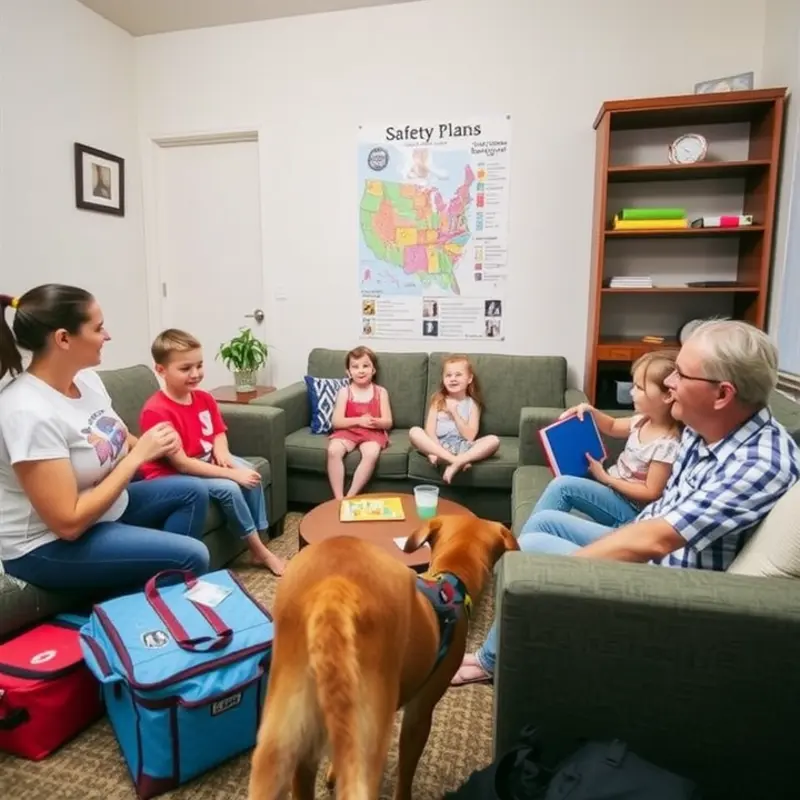Living in an apartment can be both a cozy and convenient choice for families, couples, and pet owners. Yet, ensuring safety for all members of your household, including pets, can sometimes feel challenging. Emergencies can happen unexpectedly, and being prepared is vital. Having a well-thought-out family emergency plan not only bolsters your confidence but also protects your loved ones during uncertain situations. This guide provides clear, step-by-step advice tailored for families, pet owners, and renters who seek a comfortable and child-friendly environment. Whether it’s preparing for a fire, natural disaster, or even minor emergencies, having a solid plan in place is essential. Let’s embark on this journey to create a comprehensive family emergency plan that considers your unique living situation and the needs of every family member.
Understanding Your Apartment Environment

Living in an apartment presents unique challenges when crafting a family emergency plan. Understanding the specific features of your living environment can significantly enhance safety for both your family and pets. In this chapter, we will explore key aspects that require special attention, ensuring you are well-prepared for any crisis.
Apartments are typically located in multi-unit buildings, which means shared walls, floors, and ceilings with neighbors. This proximity affects not only noise levels but also emergency response protocols. In emergencies, shared spaces like hallways, stairwells, and elevators become critical evacuation routes. It’s essential to familiarize yourself and your family with these exit strategies, noting the locations of all fire exits and nearest stairwells.
The layout of your apartment influences emergency strategies. Compact living spaces may limit your storage options for essential supplies. It is advisable to prioritize the storage of safety items such as first aid kits and emergency food and water supplies. Consider using vertical storage solutions or under-bed storage to maximize space efficiency.
Fire safety is paramount in apartment buildings due to the potential rapid spread of fires in close quarters. Installing smoke detectors in every room and ensuring they are functioning regularly is crucial. Many apartments come with pre-installed fire safety fixtures, but it’s prudent to verify their effectiveness. Regularly review your building’s fire safety plan and participate in any conducted fire drills.
Natural light and ventilation can vary greatly from unit to unit. Windows might be your only source of fresh air or emergency escape in a dire situation, especially on lower floors. Ensure that windows are accessible and easy to open. Familiarize yourself with the operation of any window security features, such as bars or child-safety locks, to ensure a swift exit if necessary.
Planning for pets in emergencies often requires additional considerations. Identify pet-friendly emergency shelters in your area and keep a portable pet carrier ready for quick evacuation. Make sure your pet’s microchip information and ID tags are up to date.
Apartment buildings that permit pets may have specific evacuation procedures; understanding these is crucial. For more insights on integrating pets into apartment living, you might find our guide on apartment playdates useful.
Communication is a key component of any emergency plan. Ensure all family members know how to contact each other and emergency services. Familiarize yourself with your building manager and building maintenance staff, as they can be invaluable in an emergency. Keep a list of essential contact numbers and ensure everyone knows where it is stored.
Lastly, consider special needs of all family members, such as young children or elderly relatives. Familiarizing them with emergency drills and ensuring they understand how to react can be lifesaving.
Understanding your apartment environment is foundational in crafting a comprehensive emergency plan. By considering the unique aspects of apartment living, you can enhance your family’s safety and ensure you are prepared for any situation.
Step-by-Step Emergency Preparedness

Preparing a comprehensive emergency plan is vital for apartment dwellers. Here’s how you can ensure your family and pets are prepared.
1. Establish a Communication Strategy
Designate a primary and secondary contact person. Ensure everyone in your family knows their phone numbers. Choose someone out-of-state for the primary contact as a regional disaster may disrupt localized communications. Hold practice calls once a month to ensure everyone remembers the plan and contacts.
2. Assemble an Emergency Safety Kit
Your emergency kit should be easy to carry and store. Use a backpack or a small suitcase on wheels. Essential items include:
- A first aid kit
- Bottled water (one gallon per person per day for three days)
- Non-perishable food for three days
- Flashlights with extra batteries
- A battery-powered or solar radio
- Multi-purpose tool
- Personal hygiene items
- Prescription medications and medical supplies
- Copies of important documents
- Cash in small denominations
- Blanket or sleeping bag per person
- Extra warm clothing and sturdy shoes
Remember to check expiration dates every six months and replenish supplies as necessary.
3. Map Out Evacuation Routes
Identify all possible exits in your apartment building. Discuss these routes with every household member. Familiarize yourself with the apartment’s fire escape or stairways, avoiding elevators in an emergency. Work with your building manager to ensure evacuation paths are clear.
4. Plan for Family Pets
Your plan should include pet-specific considerations. Have a backup plan in case shelters do not accept animals. Prepare a pet emergency kit with food, water, bowls, a leash, and any medication your pet requires. Ensure pets are microchipped and that information is up-to-date.
For more tips on preparing your space with pets in mind, refer to Apartment Playdates and Socializing.
5. Practice Your Plan
Conduct regular drills with your family to practice your emergency plan. These should include mock evacuations and communication checks. Discuss potential scenarios like fires, severe weather, or gas leaks, and practice the appropriate response for each situation.
Stay informed about local emergency procedures by signing up for alerts through your city’s emergency services. Knowing local evacuation zones and shelters adds another layer of preparedness.
By methodically organizing these aspects, you secure peace of mind and elevate your preparedness, ensuring safety and confidence during emergencies.
Final words
Preparing a family emergency plan tailored for your apartment living situation is a gift of assurance and safety. By understanding your environment and following a structured approach to develop your plan, you secure the wellbeing of every family member. Regular practice and updates to your plan ensure that everyone remains calm and ready when emergencies arise. Together, let’s ensure that your family and pets are protected in your cherished apartment home.









